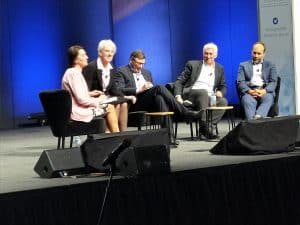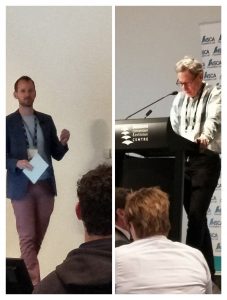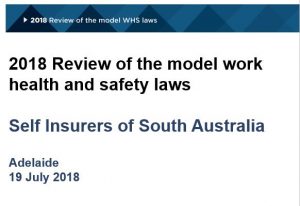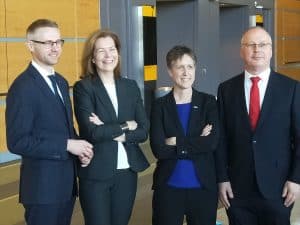 The 2018 Comcare conference currently happening in Melbourne Australia is a mixed bag, perhaps as conferences should be. There is a mix of useful information and perspectives but this has also led to mixed messages.
The 2018 Comcare conference currently happening in Melbourne Australia is a mixed bag, perhaps as conferences should be. There is a mix of useful information and perspectives but this has also led to mixed messages.
Category: conference
Safety Culture debates could be psychologically unsafe

Professor Andrew Hopkins is one of Australia’s most prominent critics of how the term “Safety Culture” is used by the occupational health and safety (OHS) profession and businesses generally. Last week, Dr Tristan Casey followed Hopkins’ presentation at a Brisbane safety conference and was put on the spot as his presentation was not really compatible. This happens at conferences and diversity of thought should be applauded but it is difficult for the second speaker and can be confusing for the audience.
Hopkins addressed seven propositions, each of which, challenge the management of OHS
Power in simplicity – SafetyCONNECT
Twelve months after the NSCA Foundation resurrected its occupational health and safety (OHS) conference program, SafetyCONNECT has settled into to a comfortable niche. This year’s conference, in an established Brisbane location has attracted around 140 delegates and almost 20 exhibitors. Perhaps most importantly is they have been able to attract entertaining and challenging local and international speakers. Continue reading “Power in simplicity – SafetyCONNECT”
Don’t let safety culture be an excuse for doing nothing
 It is a common tactic for procrastinators to acknowledge a problem and then point to an ill-defined, fluffy concept as the problem because that fluffiness makes it almost impossible to change, some use the phrase “wicked problem” similarly. The fluffy concept may be too difficult for most to understand, or the benefits will not be quick enough or not fit into an unrealistic preconceived schedule. “Safety Culture”, or the currently preferred term “organisational culture that includes safety”, is often used to justify this procrastination.
It is a common tactic for procrastinators to acknowledge a problem and then point to an ill-defined, fluffy concept as the problem because that fluffiness makes it almost impossible to change, some use the phrase “wicked problem” similarly. The fluffy concept may be too difficult for most to understand, or the benefits will not be quick enough or not fit into an unrealistic preconceived schedule. “Safety Culture”, or the currently preferred term “organisational culture that includes safety”, is often used to justify this procrastination.
At the end of August 2018,
What Boland’s Independent Review has been hearing
 On July 19 2018, Marie Boland, who is conducting an independent review into Australia’s work health and safety (WHS) laws, spoke at the Closing The Loop conference, hosted by the Self Insurers of South Australia (SISA). Boland’s inquiry has been a little quiet as it undertakes its consultation and investigation but Boland provided some insight at the SISA conference.
On July 19 2018, Marie Boland, who is conducting an independent review into Australia’s work health and safety (WHS) laws, spoke at the Closing The Loop conference, hosted by the Self Insurers of South Australia (SISA). Boland’s inquiry has been a little quiet as it undertakes its consultation and investigation but Boland provided some insight at the SISA conference.
According to Boland’s presentation (not available online),
OHS outcomes of ACTU Congress 2018
 Below is the list of occupational health and safety (OHS) issues for the next three years, put to the Australian Council of Trade Unions and passed, at its Congress on 18 July 2018. Some were expected but others will cause concern, primarily, for business owners. Perhaps the major concern is that these commitments are to be rolled out nationally.
Below is the list of occupational health and safety (OHS) issues for the next three years, put to the Australian Council of Trade Unions and passed, at its Congress on 18 July 2018. Some were expected but others will cause concern, primarily, for business owners. Perhaps the major concern is that these commitments are to be rolled out nationally.
New President and new approaches to unionism

Day One of the Australian Council of Trade Unions’ Congress was memorable for a couple of reasons. The appointment of Michele O’Neil, pictured right, as the President was a notable achievement, one made more memorable as she denied any desire to move onto a political appointment. The other memorable event was a string of shopfloor representatives outlining their innovative approaches to the recruitment of members and the creation of (sub)unions for hospitality workers, hairdressers and indigenous workers in the Northern Territory.
Workplace safety was mentioned a couple of times in passing but occupational health and safety (OHS) seems to becoming more a thing that is, rather than a thing that is named. If we look for it, we find it.
